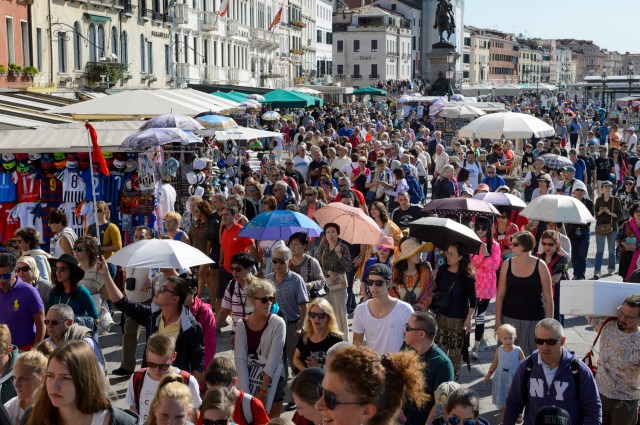Crowds of tourists on the Riva dei Schiavone in Venice, Italy. Matt Crossick/Matt Crossick/Empics Entertainment

“‘See Venice and die,’ is what they say. Or is it Rome?” Dickie Greenleef in The Talented Mr Ripley wasn’t sure. (In fact the original saying, as quoted by Goethe, is “see Naples and die”.)
A more apt slogan might be “See Venice and kill it” – because that, as Edward Lucas explains in a piece for 1843, is what globalised tourism is doing to the most beautiful city in the world:
“Over the past decade visitor numbers have grown by 5% annually, meaning that they double every 14 years. Paolo Costa, an economics professor, former mayor and now the boss of the nearby Venice Port, estimated in 1988 that the physical capacity of the historic centre was 20,000 visitors daily. The average daily flow now is 80,000 – more at the height of summer.”
That might sound like good business; and it is, for some – but not the city itself:
“Venice’s concentrated beauty is its undoing. Many tourists come just to glimpse its remarkable cityscape. They do not ask for entertainment or comfort: since the best things in Venice are free, there is no need to spend money on anything else. They do not linger: many want only to visit St Mark’s Square and be photographed in front of the Basilica. Of the 25m visitors every year, 12m are day-trippers.
“For tourists on tight budgets, this is an entirely sensible approach. For the city, it is disastrous. It means more people for less revenue, and drags Venice into a down-market spiral… Overcrowding deters the most valuable visitors. The bigger the low-budget crowds, the less attractive the place becomes for the high spenders. Top-end tourists do not want to struggle through the crowds to go to the opera or a gallery.”
A little snobby? Maybe, but who wouldn’t want to maximise the value of what they have to offer? Also, conserving Venice for future generations is a huge and costly undertaking – to deny the city the necessary revenues is short-sighted in the extreme.
Nor is this just about Venice. The rising tide of global prosperity means a rising tide of global tourism:
“As the global middle class grows, and annual foreign holidays become routine, the world’s most popular destinations face a tourism tsunami. At present only 4% of the Chinese population, 55m people, own a passport. When passport ownership in China reaches the Japanese rate, 340m Chinese people will have passports; when it reaches the American rate, 450m will.
“‘Venice is a laboratory – what happens here will happen elsewhere,’ says Vincenzo Casali, an architect who lives and works by the Rialto.”
Europe is Venice writ large – a concentration of urban beauty that is without parallel anywhere in the world. There were, of course, great cities in places like China, India and the Middle East when Europeans were still living in huts. But in the sheer quantity and accessibility of surviving architectural heritage the historic towns and cities of Europe are a global draw.
It’s a wonderful thing that so many more people on our planet now have the means to visit other parts of the planet, but these flows of humanity have to be managed for the common good – and, indeed, for the particular good of the destination communities.
In this respect tourism is a parallel to the more permanent business of immigration. In both cases, there is powerful lobby for the poorly regulated status quo – either because of commercial vested interests or because of an ideological commitment to open borders. Those who make money from either unsustainable tourism or uncontrolled immigration should be faced down; but the latter group – the open borders idealists – need to be reasoned with.
The alternative to sensible controls isn’t no controls, but the growing risk of a damaging backlash.










Join the discussion
Join like minded readers that support our journalism by becoming a paid subscriber
To join the discussion in the comments, become a paid subscriber.
Join like minded readers that support our journalism, read unlimited articles and enjoy other subscriber-only benefits.
Subscribe